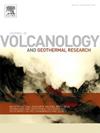自相似的火山口空间聚类:来自全球火山场的岩浆储存深度洞察
IF 2.3
3区 地球科学
Q2 GEOSCIENCES, MULTIDISCIPLINARY
Journal of Volcanology and Geothermal Research
Pub Date : 2025-08-16
DOI:10.1016/j.jvolgeores.2025.108431
引用次数: 0
摘要
火山场中火山口的空间分布为研究下伏岩浆管道系统的结构以及地壳结构和应力状态对岩浆上升的影响提供了重要的信息。本研究调查了46个不同大地构造背景的火山场的自相似喷口聚类,以评估喷口分布是否始终遵循分形模式,而不考虑参数统计分类。利用最近邻距离、喷口至喷口距离和核密度估算的空间分析证实,喷口自相似聚类是分布式火山活动的基本特征。分析表明,自相似的聚类存在于所有的火山场,即使在参数方法表明随机或过度分散分布的情况下也是如此。喷口自相似聚类在一个长度范围内定义,该长度范围由两个阈值界定,即下限(Lco)和上限(Uco)截止。它们分别对应于岩浆可能积聚而不会导致喷发的浅深度(< 5km)和岩浆库或岩脉扩展带的深度。Uco值与岩浆储层深度(H)呈正相关,表明火山口聚集反映了地下岩浆运移动力学。统计测试证实,以前为埃塞俄比亚主裂谷的火山田定义的γ₁和γ₂参数是火山口聚集的有效指标,聚集的火山田的γ₁始终≤0.1。这些发现强调了裂缝网络作为岩浆上升的有效途径的作用,支持了岩浆渗出点与地壳力学特性内在联系的假设。未来的研究应探索裂缝网络演化如何随时间影响喷口分布,以及喷口自相似聚类分析是否可以改善对岩浆储层动力学和喷发预测的约束。此外,将这一框架应用于地外火山场(例如火星)可以为不同行星环境中控制喷口聚集的普遍过程提供新的见解。本文章由计算机程序翻译,如有差异,请以英文原文为准。
Self-similar spatial clustering of volcanic vents: Insights into magma storage depth from global volcanic fields
The spatial distribution of volcanic vents in volcanic fields provides critical insights into the structure of underlying magma plumbing systems and the influence of crustal structures and state of stress on magma ascent. This study investigates self-similar clustering of vents in 46 volcanic fields from diverse geotectonic settings to assess whether vent distribution consistently follows fractal patterns, regardless of parametric statistical classifications. Spatial analyses using Nearest Neighbour Distance, Vent-to-Vent Distance and Kernel Density Estimation confirm that the vent self-similar clustering is a fundamental characteristic of distributed volcanism.
The analysis reveals that self-similar clustering is present in all volcanic fields, even in cases where parametric methods suggest a random or over-dispersed distribution. The vent self-similar clustering is defined within a length range bounded by two thresholds, the lower (Lco) and the upper (Uco) cut-offs. They correspond to the shallow depth (< 5 km) at which magma may accumulate without leading to eruption and the depth of the magma reservoir or dike propagation zone, respectively. A strong positive correlation between Uco and magma reservoir depth (H) suggests that vent clustering reflects subsurface magma transport dynamics. Statistical tests confirm that γ₁ and γ₂ parameters, previously defined for volcanic fields in the Main Ethiopian Rift, are effective indicators of vent clustering, with γ₁ consistently ≤0.1 for clustered fields.
These findings underscore the role of fracture networks as efficient pathways for magma ascent, supporting the hypothesis that magma effusion sites are intrinsically linked to crustal mechanical properties. Future research should explore how fracture network evolution influences vent distribution over time and whether the vent self-similar clustering analysis can improve constraints on magma reservoir dynamics and eruption forecasting. Furthermore, applying this framework to extraterrestrial volcanic fields (e.g., Mars) could provide new insights into universal processes governing vent clustering in different planetary environments.
求助全文
通过发布文献求助,成功后即可免费获取论文全文。
去求助
来源期刊
CiteScore
5.90
自引率
13.80%
发文量
183
审稿时长
19.7 weeks
期刊介绍:
An international research journal with focus on volcanic and geothermal processes and their impact on the environment and society.
Submission of papers covering the following aspects of volcanology and geothermal research are encouraged:
(1) Geological aspects of volcanic systems: volcano stratigraphy, structure and tectonic influence; eruptive history; evolution of volcanic landforms; eruption style and progress; dispersal patterns of lava and ash; analysis of real-time eruption observations.
(2) Geochemical and petrological aspects of volcanic rocks: magma genesis and evolution; crystallization; volatile compositions, solubility, and degassing; volcanic petrography and textural analysis.
(3) Hydrology, geochemistry and measurement of volcanic and hydrothermal fluids: volcanic gas emissions; fumaroles and springs; crater lakes; hydrothermal mineralization.
(4) Geophysical aspects of volcanic systems: physical properties of volcanic rocks and magmas; heat flow studies; volcano seismology, geodesy and remote sensing.
(5) Computational modeling and experimental simulation of magmatic and hydrothermal processes: eruption dynamics; magma transport and storage; plume dynamics and ash dispersal; lava flow dynamics; hydrothermal fluid flow; thermodynamics of aqueous fluids and melts.
(6) Volcano hazard and risk research: hazard zonation methodology, development of forecasting tools; assessment techniques for vulnerability and impact.

 求助内容:
求助内容: 应助结果提醒方式:
应助结果提醒方式:


